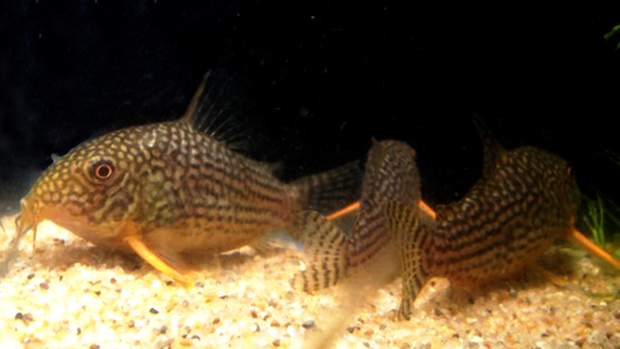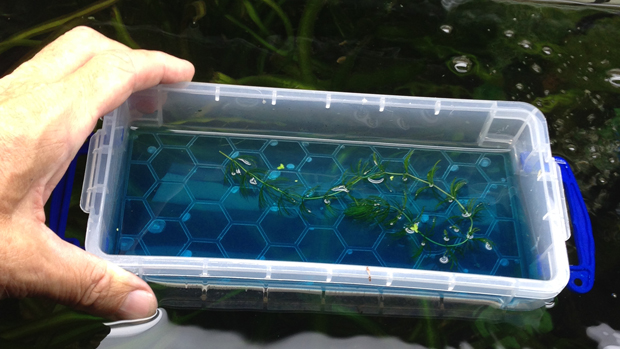Breeding Corydoras sterbai Cats

Published 20210823
It is 1962, I am twelve years old, and my dwarf gouramis are moving around their fifteen-gallon aquarium like they want to spawn. I will need live baby brine shrimp to feed the fry so it is time to construct a brine shrimp hatchery. When I was a kid there were no such items as clear plastic bottles. To make a hatchery we used one-gallon glass jugs that were common at the time. My family’s next-door neighbor drank wine from clear gallon jugs, so I swiped a few of them out of his garbage can. Making the hatcheries required cutting off the bottom of the jug. To do this, a glass cutter was used to scratch a line one inch from the bottom around the circumference of the container. Next, a string was tied around the jug that straddled the scratched line. The string was soaked with lighter fluid and ignited. After burning for a few seconds, the glass jug was plunged into a pail of ice water. If lucky, the expansion and contraction of the glass broke off the bottom of the container in a neat even piece. It was necessary to build a stool out of plywood with a hole to hold the jug upside down. With a cork in the neck and a rigid piece of airline through the cork, attached to an airline, you were ready to start hatching shrimp.
It was now 2020 and I wanted to breed some cory cats. I procrastinated because I knew I needed to construct a brine shrimp hatchery. Although, I didn’t need a gallon glass jug my brine shrimp hatchery setup was going to be a little cumbersome. My fish room is in the garage and while insulated it still gets cold in the winter, so the shrimp water required heat. I decided the most dependable solution was to keep my DIY one- liter hatcheries submerged in a heated five-gallon tank. Installing the hooks and chains to support the bottles was not complicated, but the final apparatus seemed like a messy way to raise shrimp. Using the eggs I ordered from Brine Shrimp Direct, aside from the watery mess created each time I collected shrimp, my hatching set-up worked pretty well.
Lee’s Feed is the nearest store to my house that carries fish. About eighteen months ago I purchased six Corydoras sterbai cats from there. I housed them in a fifty-five gallon tank with some bushy nose plecos and a group of glow-light tetras. My water comes from El Dorado Irrigation District with a general hardness and carbonate hardness both less than 30 ppm. The pH from the tap fluctuates between 7.4 and 7.6. There is not much in the water to buffer the pH and it dips well below 7.0 after a few days following my weekly 50% water changes. I eventually added a box filter, half-filled with crushed coral, to keep the ph more stable.
One morning, about six months after bringing home the sterbais, I discovered about 30 eggs stuck to the front glass of the aquarium. I was unprepared for this exciting event and didn’t have a plan for dealing with eggs. I decided to do some research and take action the next day. The following morning, no action was needed; all the eggs were gone. YouTube is where I surf for information on just about everything. While searching my favorite blogs I came across a clip produced by Aquarium Coop. It was an interview with Cory’s friend Dean. Dean uses plastic trays he floats in aquariums to raise fish fry. Using Dave’s idea, I purchased some shallow plastic trays that were four inches wide, eight inches long, and one and half inches deep.
A few weeks after the first spawn, the sterbais laid another batch of eggs, again on the front glass. Initially, I used a single-edged razor blade to scrap the eggs off the glass but discovered that it was easier to brush them off with my finger. I put the sticky eggs into two of the plastic trays filled with an inch of aquarium water, a drop of methylene blue, and a sprig of hornwort. I placed the tops on the trays and floated them in the fifty-five gallon tank. Four days later the eggs started to hatch. A couple of days after that most of the fry had used up their egg sacs and I started feeding them micro worms. I fed micro worms for two weeks then switched to live baby brine shrimp and Tetramin flakes that I ground up in a mortar and pestle. Every day I used a pipette to suck out any uneaten food, any fungused eggs and a portion of water to be replaced by fresh aquarium water. When the sterbai fry was two months old I let them lose in a twenty-gallon grow-out tank.

Since that first group of eggs I saved, the corys have spawned several more times, but on each occasion, there were only ten or twelve eggs on the glass. I assumed any additional eggs had been eaten. I used the plastic trays for two more of the spawns, but another YouTube clip described the use of a breeder box to raise fry from eggs. I ordered an ISTA outside hanging breeder box from Amazon. I didn’t use methylene blue dye in the breeder box, but I found it just as effective and much simpler to use than the plastic trays.
The fifty-five-gallon aquarium that houses the adult sterbais is heavily planted with hornwort, Vallisneria, and Java moss. I hadn’t seen any eggs for several months, but one day I discovered several sterbai cats that were less than a half-inch long. I was surprised to see that some of the eggs and fry were surviving with the other fish in the tank.
I think sterbais are one of the more attractive corys and breeding them was done with little help from me. I feed the adults twice a day. I use Tetramin flakes in the morning and sinking shrimp pellets in the evening. Every three or four days I replace the morning flake food with a mixture of frozen shrimp and frozen blood worms. I have never fed the adults any live food. I think my water chemistry is comfortable for the corys and the 50% water changes might give them the encouragement they need to spawn. At least four times, when it rained, there were eggs on the glass the next day.

